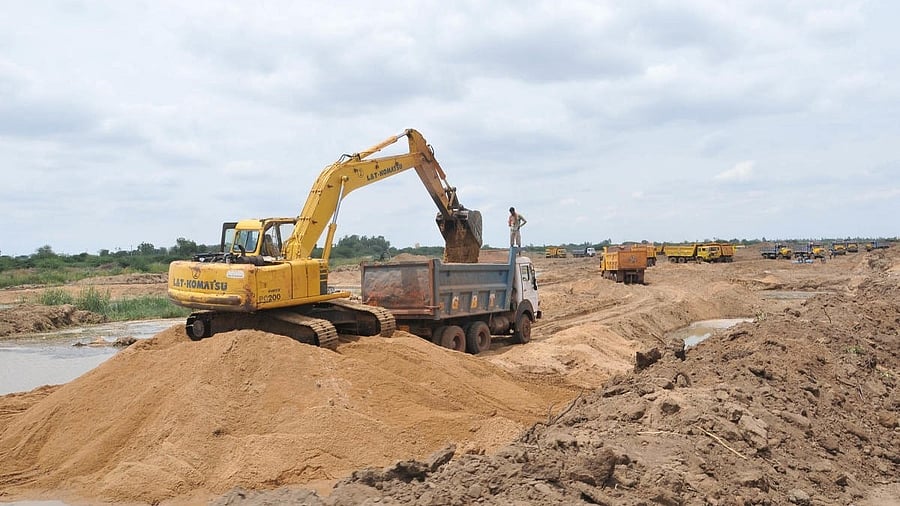
Representative image of sand mining.
Credit: iStock Photo
Bengaluru: The Karnataka government's amalgamation of illegal mines with legal mines and their subsequent auction as single blocks have violated several conditions laid down by the Supreme Court and led to possible loss to the exchequer, the Central Empowered Committee has flagged, recommending a review of the auction of five mining blocks spread over 4,500 acres.
The state government attracted the CEC's ire after it prepared the five blocks, located in Ballari district, for auction by stitching together 'C' category mines (illegal), legal mines and forest areas to make them appealing to big companies.
The five blocks are: Vyasanakere (1,001.76 acre), Jaisinghpura South (1,221.83 acre), Jaisinghpura North (1,490.44 acre), Somanahalli block (670.94 acre) and HR Gaviappa (98.94 acre).
With the CEC raising objections, the state government has filed a petition before the apex court, seeking post facto approval.
"Despite clear directions of this Hon'ble court, the state government proceeded to amalgamate other categories of mines and also fresh virgin forest area with 'C' category mines, and auction them in violation of orders dated July 30, 2015, and April 18, 2013. The auction process has since been completed," the CEC said.
The committee flagged several violations, comparing the conditions imposed by the apex court in 2015 with the state government's conditions during the bidding process.
It noted that the amalgamation itself was a clear violation as it changed the mining boundary. This is because the legal regime for treatment of 'C' category mines is different from that of 'A' (legal) and 'B' (partly legal) category mines and the virgin fresh forest lands. The 'C' category mines required a comprehensive R&R programme.
Apart from the issues with amalgamation, the CEC pointed out that while the apex court had limited the auction to end-users engaged in producing iron, steel or pellets, the government auctioned the five blocks without any such restrictions.
Moreover, the court had ordered that the production limit should be as prescribed under the rehabilitation and resettlement (R&R) plan. In the present case, the government allowed the preferred bidder to prepare the R&R plan, instead of government agencies, opening the door for potential opaque practices.
The court had also put a condition mandating the dispatch of 50% of the permissible annual production. "In the new system, as there are no provisions of guaranteed dispatch, the state government may suffer a loss of yearly revenue," the CEC said.
The Supreme Court has ruled that 25% of the sale proceeds of the auction in 'C' category mines should go to the special purpose vehicle (SPV) to restore mining-affected areas. However, in the case of the amalgamated blocks, the amount to be transferred to the SPV will be only 10% of the sale proceeds, the report noted.
Further, the committee observed that R&R plans were not prepared for 'C' category mines in some cases. It cited the lack of such plans for 'C' category mines in Jaisinghpura North and Somanahalli blocks. "It is also observed that some of the areas of old leases of A, B and C categories have been excluded from the blocks. The R&R plan for such left-out areas is not being implemented. And there is no indication as to who will implement the R&R plans for such areas," the report said.
S R Hiremath of the NGO Samaj Parivartana Samudaya said the report not only highlights the series of violations but also underscores the government's failure to restore mining-affected areas.
"We will file a response in the Supreme Court, requesting a comprehensive view of the situation. The larger issue is the iron ore production itself. The oversight authority of the Karnataka Mining Environment Restoration Corporation had preferred a production cap of 20 million tonne per annum (MTPA). However, the monitoring committee and the CEC want the production at 57 MTPA; this at a time when people are unable to bear the destruction and pollution caused by the current production levels of 50 MTPA. We will urge the court for a ruling that takes into consideration justice for the people affected by mining as well as intergenerational justice," he said.